Inside Egypt’s Great Pyramid of Giza lies a mysterious cavity, its void unseen by any living human, its surface untouched by modern hands. But luckily, scientists are no longer limited by human senses.
To feel out the contours of the pyramid’s unexplored interior, scientists followed the paths of tiny subatomic particles called muons. Those particles, born high in Earth’s atmosphere, hurtled toward the surface and burrowed through the pyramid. Some of the particles imprinted hints of what they encountered on sensitive detectors in and around the pyramid. The particles’ paths revealed the surprising presence of the hidden chamber, announced in 2017 (SN: 11/25/17, p. 6).
That stunning discovery sparked plans among physicists to use muons to explore other archaeological structures. And some researchers are using the technique, called muography, to map out volcanoes’ plumbing. “You can see inside the volcano, really,” says geophysicist Giovanni Leone of Universidad de Atacama in Copiapó, Chile. That internal view could give scientists more information about how and when a volcano is likely to erupt.

Sign Up For the Latest from Science News
Headlines and summaries of the latest Science News articles, delivered to your inbox
Client key* E-mail Address* Go
Thank you for signing up!
There was a problem signing you up.
Muons are everywhere on Earth’s surface. They’re produced when high-energy particles from space, known as cosmic rays, crash into Earth’s atmosphere. Muons continuously shower down through the atmosphere at various angles. When they reach Earth’s surface, the particles tickle the insides of large structures like pyramids. They penetrate smaller stuff too: Your thumbnail is pierced by a muon about once a minute. Measuring how many of the particles are absorbed as they pass through a structure can reveal the density of an object, and expose any hidden gaps within.
The technique is reminiscent of taking an enormous X-ray image, says Mariaelena D’Errico, a particle physicist at the National Institute for Nuclear Physics in Naples, Italy, who studies Mount Vesuvius with muons. But “instead of X-rays, we use … a natural source of particles,” the Earth’s very own, never-ending supply of muons.
Physicists have typically studied cosmic rays to better understand the universe from whence they came. But muography turns this tradition on its head, using these cosmic particles to learn more about previously unknowable parts of our world. For the most part, says particle physicist Hiroyuki Tanaka of the University of Tokyo, “particles arriving from the universe have not been applied to our regular lives.” Tanaka and others are trying to change that.
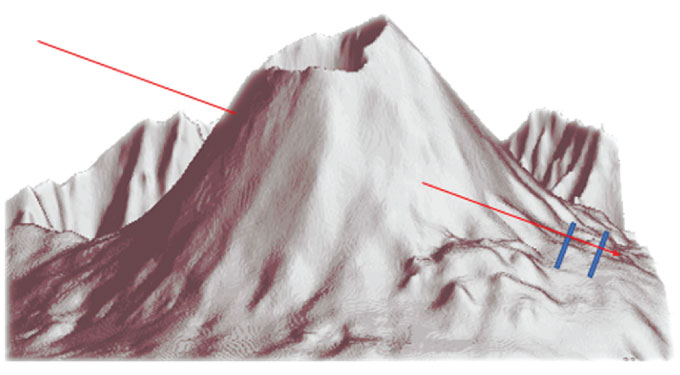 To visualize the inner workings of a volcano, scientists capture muons that pass through (one track illustrated in red) and onto particle detectors (blue). By determining where the muons pierced the volcano, scientists can map out the density of the material.G. Bonomi et al/Progress in Particle and Nuclear Physics 2020
To visualize the inner workings of a volcano, scientists capture muons that pass through (one track illustrated in red) and onto particle detectors (blue). By determining where the muons pierced the volcano, scientists can map out the density of the material.G. Bonomi et al/Progress in Particle and Nuclear Physics 2020
No particle like it
Awkward cousins of electrons, muons may seem like an unnecessary oddity of physics. When the particle’s identity was first revealed, physicists wondered why the strange particle existed at all. While electrons play a crucial role in atoms, the heavier muons serve no such purpose.
But muons turn out to be ideal for making images of the interiors of large objects. A muon’s mass is about 207 times as large as an electron’s. That extra bulk means muons can traverse hundreds of meters of rock or more. The difference between an electron and a muon passing through matter is like the difference between a bullet and a cannonball, says particle physicist Cristina Cârloganu. A wall may stop a bullet, while a cannonball passes through.
Muons are plentiful, so there’s no need to create artificial beams of radiation, as required for taking X-ray images of broken bones in the doctor’s office, for example. Muons “are for free,” says Cârloganu, of CNRS and the National Institute of Nuclear and Particle Physics in Aubière, France.
Particle shower
Protons and other high-energy particles from space hit Earth’s atmosphere and generate a deluge of other particles. Pions and kaons can decay into muons, some of which reach Earth’s surface, along with difficult-to-detect neutrinos.
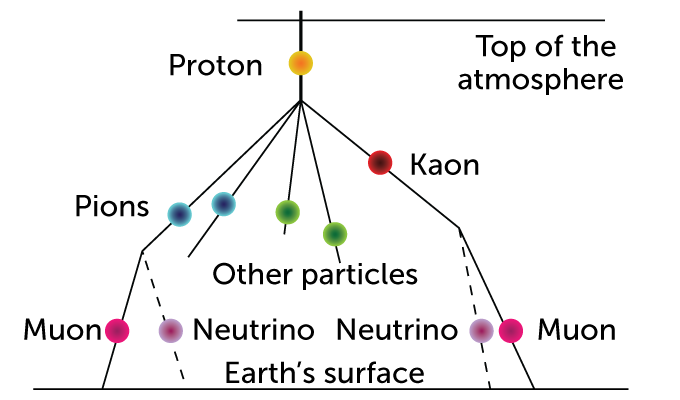 T. TibbittsT. Tibbitts Source: A. Giammanco
T. TibbittsT. Tibbitts Source: A. Giammanco
Another crucial upside of muons: “They’re also very easy to detect,” says nuclear physicist Richard Kouzes of the Pacific Northwest National Laboratory in Richland, Wash. A simple detector made of strips of plastic and light sensors will do the trick. Other muon detectors require little more than a specialized version of photographic film. There’s no other particle like it, Kouzes says.
Muons have a negative electric charge, like an electron. Their antiparticles, antimuons, which also shower down on Earth, have a positive charge. Muon detectors capture tracks of both negatively and positively charged varieties. When these particles pass through material, they lose energy in various ways, for example, by colliding with electrons and knocking them loose from their atoms.
With that energy loss, muons slow down, sometimes enough to stop. The denser the material, the fewer muons will make it through to a detector placed underneath or to the side of the material. So large, dense objects such as volcanoes or pyramids cast a muon shadow. And any gaps within those structures will appear as bright spots within that shadow, because more muons can slip through. Interpreting such dappled shadows can open a vista into hidden worlds.
Probing pyramids
Muography proved itself in a pyramid. One of the first uses of the technique was in the 1960s, when physicist Luis Alvarez and colleagues looked for hidden chambers in Khafre’s pyramid in Giza, a slightly smaller neighbor of the Great Pyramid. Detectors found no hint of unexpected rooms, but proved that the technique worked.
Still, the idea took time to take off, because muon detectors of the era tended to be bulky and worked best in well-controlled laboratory conditions. To spot the muons, Alvarez’s team used detectors called spark chambers. Spark chambers are filled with gas and metal plates under high voltage, so that charged particles passing through create trails of sparks.
Now, thanks to advances in particle physics technologies, spark chambers have largely been replaced. “We can make very compact, very sturdy detectors,” says nuclear physicist Edmundo Garcia-Solis of Chicago State University. Those detectors can be designed to work outside a carefully controlled lab.
One type of resilient detector is built with plastic containing a chemical called scintillator, which releases light when a muon or other charged particle passes through (SN Online: 8/5/21). The light is then captured and measured by electronics. Later this year, physicists will use these detectors to take another look at Khafre’s pyramid, Kouzes and colleagues reported February 23 in the Journal for Advanced Instrumentation in Science. Compact enough to fit within two large carrying cases, the detector “can be carried into the pyramid and then operated with a laptop and that’s all,” Kouzes says.
A look inside
Scientists placed three different types of muon detectors in and around the Great Pyramid to map out the density of the structure and search for hidden chambers.
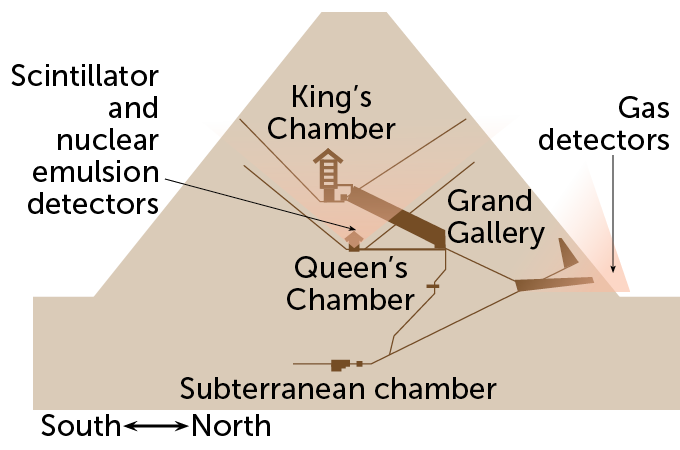 T. TibbittsT. Tibbitts Source: K. Morishima et al/Nature 2017
T. TibbittsT. Tibbitts Source: K. Morishima et al/Nature 2017
A different but particularly low-maintenance type of detector, called a nuclear emulsion film, was crucial to uncovering the Great Pyramid’s hidden void in 2017. Nuclear emulsions record particle tracks in a special type of photographic film. The detectors are left in place for a period of time, then brought back to a lab for analysis of the tracks imprinted in them.
Particle physicist Kunihiro Morishima of Nagoya University in Japan helped discover the secret chamber through work on an international project called ScanPyramids. “Nuclear emulsions are lightweight, compact and do not require a power supply,” he explains. That meant that multiple detectors could be placed in prime viewing locations in one of the pyramid’s rooms, the Queen’s Chamber, and a small niche next to it. The detectors’ measurements were supplemented with plastic scintillator detectors inside the Queen’s Chamber, and gas-based detectors outside the pyramid.
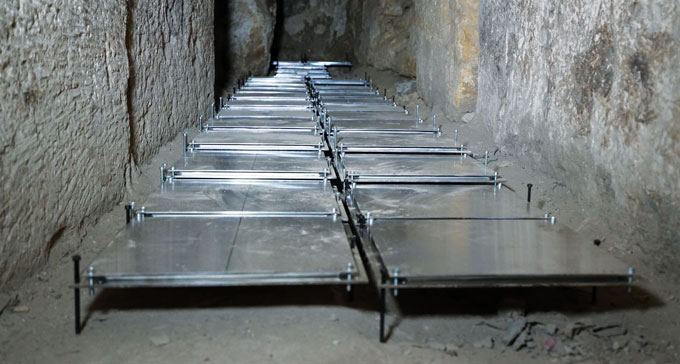 Nuclear emulsion detectors are compact enough to be installed in a small niche next to the Queen’s Chamber in the Great Pyramid.Nagoya Univ.
Nuclear emulsion detectors are compact enough to be installed in a small niche next to the Queen’s Chamber in the Great Pyramid.Nagoya Univ.
Since the discovery of the void, Morishima and colleagues have been taking additional measurements to better sketch out its properties. The team placed emulsion detectors in 20 locations in the pyramid, as well as gas detectors in several different spots. Using their new array of instruments, the researchers determined that the void is over 40 meters long. Its purpose is still unknown.
A more extensive survey of the Great Pyramid, placing much larger detectors outside the pyramid, is being planned by another team of researchers. The detectors will be periodically moved to measure muons from multiple angles, the team reported March 6 in the Journal for Advanced Instrumentation in Science. The result, says coauthor and particle physicist Alan Bross of Fermilab in Batavia, Ill., will offer a 3-D view of what’s inside (SN: 12/18/21 & 1/1/22, p. 44).
Pyramids in other parts of the world are also getting closer scrutiny. Garcia-Solis and colleagues are now planning muography of the Maya pyramid known as El Castillo at Chichén Itzá in Mexico. Morishima and colleagues, as well, are planning work on Maya pyramids.
Scientists hope such studies might reveal new chambers, or features not visible with other techniques for peering inside of objects. Ultrasound, ground-penetrating radar or X-rays, for example, can only penetrate a short distance from the surface, Bross explains. Muons, on the other hand, give an in-depth picture. For studying pyramids, Bross says, “muons really are ideal.”
Peering inside a volcano
Vesuvius is a known menace in Naples and the surrounding municipalities that snuggle up against the volcano’s flanks. Infamous for destroying the ancient city of Pompeii in A.D. 79, the volcano has been quiescent since 1944, when a major eruption destroyed several nearby villages (SN: 2/29/20, p. 5). But if it erupted, it would endanger the lives of roughly 600,000 people who live closest to it, and many others in the vicinity.
“Vesuvius always scared me,” D’Errico says. “I was born and I live under this volcano.” Now, as part of the Muon Radiography of Vesuvius experiment, or MURAVES, she seeks to better understand the volcano and its dangers.
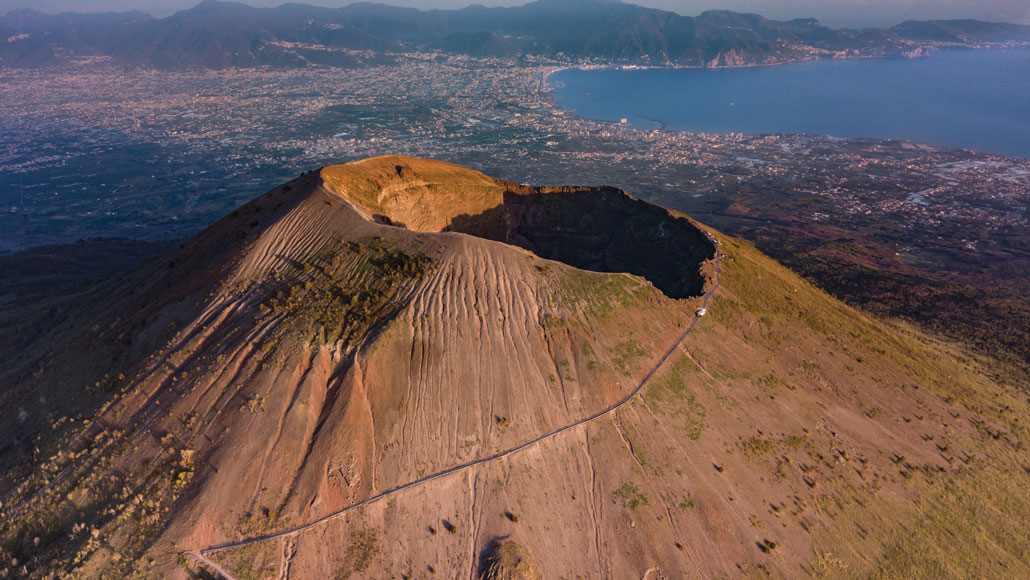 With Naples and several other communities in Italy dangerously close to Mount Vesuvius, scientists are using muography to try to predict the volcano’s hazards.The Dronaut/Wikimedia Commons (CC BY-SA 4.0)
With Naples and several other communities in Italy dangerously close to Mount Vesuvius, scientists are using muography to try to predict the volcano’s hazards.The Dronaut/Wikimedia Commons (CC BY-SA 4.0)
Using muon detectors 1.5 kilometers from the volcano’s crater, the team is mapping out muon densities — and thus rock densities — at the top of Vesuvius’ cone. In a paper posted February 24 at arXiv.org, the researchers presented preliminary hints of density differences between the volcano’s northwestern and southeastern halves. MURAVES is still collecting data; future observations should help scientists understand finer details of the volcano’s internal structure, which is thought to be layered due to repeated eruptions.
Information about a volcano’s structure can help scientists predict what hazards to expect in an eventual eruption, such as where landslides might occur. And that could help scientists know what steps to take to reduce risks to people living nearby, says Cârloganu, who studied the dormant volcano Puy de Dôme near Clermont-Ferrand, France, with muography and is now working to image the aptly named island of Vulcano in Italy.
When Mount St. Helens in Washington erupted in 1980, for example, an entire flank of the volcano collapsed. The disaster killed 57 people and caused widespread damage. Knowing where a volcano’s structural weaknesses lie could help scientists better predict how an eruption might play out, and what areas sit inside the danger zone, Cârloganu says.
Cârloganu thinks muons will be useful for pointing out structural weaknesses, but not for giving a warning when the volcano is going to blow. Other researchers are more optimistic about muons’ capability for giving timely forewarnings.
Muography is ripe for inclusion in volcano early-warning systems, Leone, Tanaka and colleagues wrote last November in Proceedings of the Royal Society A. But more work needs to be done to integrate muography with other established methods that help warn of an upcoming eruption, Leone says. These methods include seismic measurements, as well as observations of ground deformation and volcanic gas emissions.
Tanaka and colleagues are studying Sakurajima, one of the most active volcanoes in the world, near Kagoshima, Japan. One of the volcano’s craters, the Showa crater, erupted frequently until 2017 when the activity abruptly shifted to another crater, Minamidake. Comparing muography data taken before and after this shift revealed that a new, dense region had formed below the Showa crater, Tanaka and colleagues reported in 2019 in Geophysical Research Letters. That hints at the reason Showa’s eruptions stopped: It was clogged with a dense plug of solidified magma, Tanaka says.
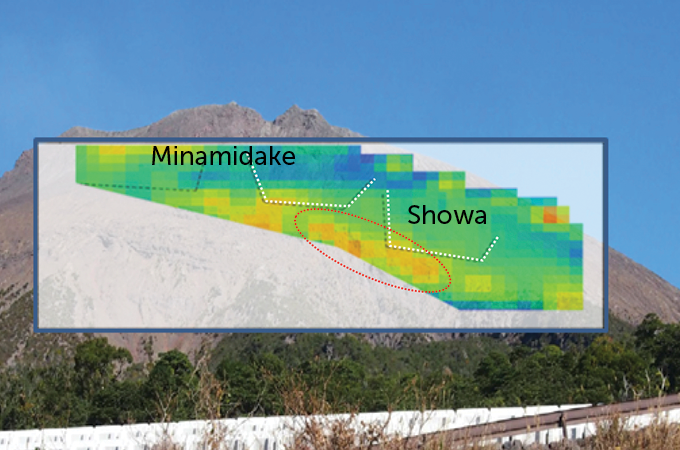 Muography revealed a newly formed plug of denser material (red oval) below the Showa crater of the Sakurajima volcano in Japan. This muography image, made with data taken in 2018 and overlaid on a photo of the volcano, hinted at why the crater stopped erupting. Redder colors indicate denser material, while blue is less dense.László Oláh and H.K.M. Tanaka
Muography revealed a newly formed plug of denser material (red oval) below the Showa crater of the Sakurajima volcano in Japan. This muography image, made with data taken in 2018 and overlaid on a photo of the volcano, hinted at why the crater stopped erupting. Redder colors indicate denser material, while blue is less dense.László Oláh and H.K.M. Tanaka
These results suggest that scientists can use muography to help predict volcanic eruptions, Tanaka says. In fact, using deep learning techniques on the muography data from Sakurajima, Tanaka and colleagues reported in Scientific Reports in 2020 that they were able to predict whether the volcano would erupt the next day, by analyzing the previous week’s data. The technique correctly predicted eruption days of the volcano more than 72 percent of the time, and correctly predicted non-eruption days more than 85 percent of the time.
Just as the discovery of X-rays unveiled a whole new way of seeing the world, harnessing muons could change our perspective on our surroundings. Attitudes toward a particle once thought to be unnecessary — unwanted and unloved by physicists — have been transformed. One day, perhaps, muons could save lives.
Contraband revealed
Superman’s X-ray vision was impressive. But some scientists might prefer muon vision. For example, muons could help officials peer inside closed shipping containers “to see if there is something suspicious inside,” says particle physicist Andrea Giammanco of the Université Catholique de Louvain in Belgium. A European Union–funded project called Silent Border aims to develop a method to uncover dangerous contraband at customs checkpoints without having to physically open and inspect every container that passes through.
The key to this technique is measuring how muons scatter. When muons pass through a material, some are absorbed and some scatter, changing direction. Using detectors above and below an object, scientists can observe how a muon’s trajectory changes as it passes through the object. Since muons tend to scatter away at larger angles in materials made of heavier elements, this technique can reveal substances such as uranium.
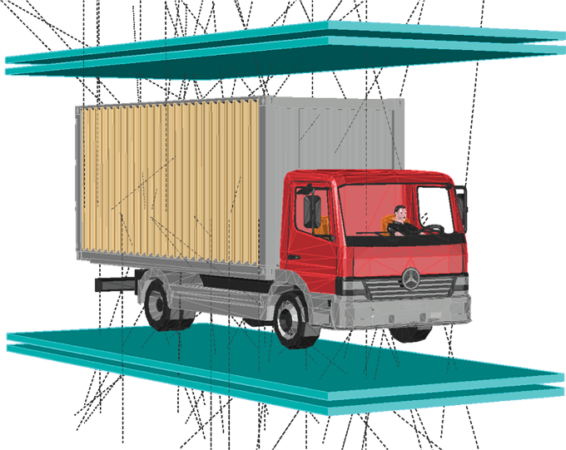 Using detectors above and below a shipping container, scientists could measure how muons scatter inside the container, as a way to root out dangerous materials.L. Bonechi, R. D’Alessandro and A. Giammanco/Reviews in Physics 2020
Using detectors above and below a shipping container, scientists could measure how muons scatter inside the container, as a way to root out dangerous materials.L. Bonechi, R. D’Alessandro and A. Giammanco/Reviews in Physics 2020
Muon scattering measurements could also be useful for peering into nuclear waste storage containers to verify what’s inside, ruling out any theft of dangerous substances or other funny business.
Separately, Giammanco and colleagues are studying muon scattering for measuring strong magnetic fields, which could be useful for monitoring certain technologies that rely on that magnetic might. That includes experimental nuclear fusion reactors that scientists hope could one day power the planet (SN: 2/6/16, p. 18). — Emily Conover

